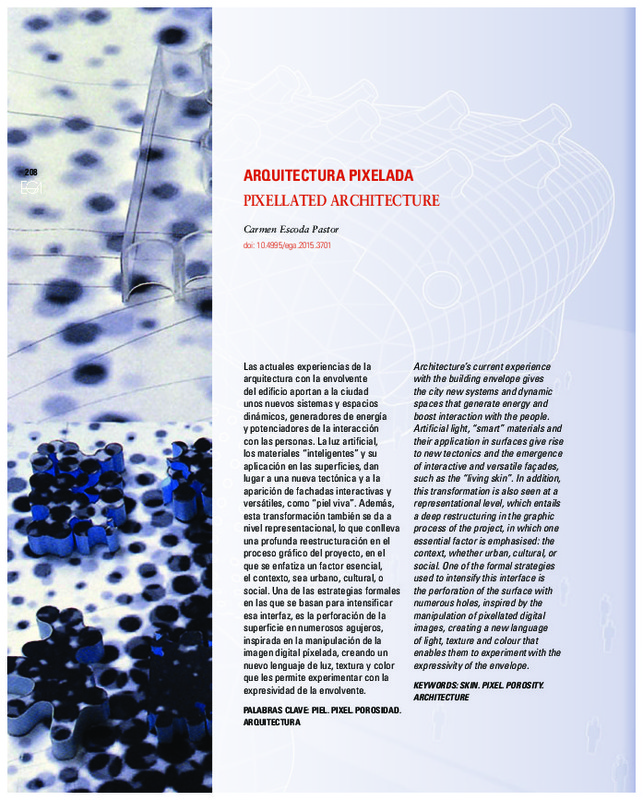JavaScript is disabled for your browser. Some features of this site may not work without it.
Buscar en RiuNet
Listar
Mi cuenta
Estadísticas
Ayuda RiuNet
Admin. UPV
Arquitectura pixelada
Mostrar el registro sencillo del ítem
Ficheros en el ítem
| dc.contributor.author | Escoda Pastor, Carmen
|
es_ES |
| dc.date.accessioned | 2017-01-03T12:04:01Z | |
| dc.date.available | 2017-01-03T12:04:01Z | |
| dc.date.issued | 2015-06-22 | |
| dc.identifier.issn | 1133-6137 | |
| dc.identifier.uri | http://hdl.handle.net/10251/76234 | |
| dc.description.abstract | [EN] Architecture’s current experience with the building envelope gives the city new systems and dynamic spaces that generate energy and boost interaction with the people. Artificial light, “smart” materials and their application in surfaces give rise to new tectonics and the emergence of interactive and versatile façades, such as the “living skin”. In addition, this transformation is also seen at a representational level, which entails a deep restructuring in the graphic process of the project, in which one essential factor is emphasised: the context, whether urban, cultural, or social. One of the formal strategies used to intensify this interface is the perforation of the surface with numerous holes, inspired by the manipulation of pixellated digital images, creating a new language of light, texture and colour that enables them to experiment with the expressivity of the envelope | es_ES |
| dc.description.abstract | [ES] Las actuales experiencias de la arquitectura con la envolvente del edificio aportan a la ciudad unos nuevos sistemas y espacios dinámicos, generadores de energía y potenciadores de la interacción con las personas. La luz artificial, los materiales “inteligentes” y su aplicación en las superficies, dan lugar a una nueva tectónica y a la aparición de fachadas interactivas y versátiles, como “piel viva”. Además, esta transformación también se da a nivel representacional, lo que conlleva una profunda reestructuración en el proceso gráfico del proyecto, en el que se enfatiza un factor esencial, el contexto, sea urbano, cultural, o social. Una de las estrategias formales en las que se basan para intensificar esa interfaz, es la perforación de la superficie en numerosos agujeros, inspirada en la manipulación de la imagen digital píxelada, creando un nuevo lenguaje de luz, textura y color que les permite experimentar con la expresividad de la envolvente | es_ES |
| dc.language | Español | es_ES |
| dc.language | Inglés | es_ES |
| dc.publisher | Universitat Politècnica de València | |
| dc.relation.ispartof | EGA. Revista de Expresión Gráfica Arquitectónica | |
| dc.rights | Reserva de todos los derechos | es_ES |
| dc.subject | Pixel | es_ES |
| dc.subject | Porosidad | es_ES |
| dc.subject | Arquitectura | es_ES |
| dc.subject | Fachadas interactivas | es_ES |
| dc.subject | Torre Agbar, Barcelona | es_ES |
| dc.subject | Muelle de Enlace en Santa Cruz de Tenerife | es_ES |
| dc.subject | Kunsthaus in Graz | es_ES |
| dc.title | Arquitectura pixelada | es_ES |
| dc.title.alternative | PIXELLATED ARCHITECTURE | es_ES |
| dc.type | Artículo | es_ES |
| dc.date.updated | 2017-01-03T11:20:37Z | |
| dc.identifier.doi | 10.4995/ega.2015.3701 | |
| dc.rights.accessRights | Abierto | es_ES |
| dc.description.bibliographicCitation | Escoda Pastor, C. (2015). Arquitectura pixelada. EGA. Revista de Expresión Gráfica Arquitectónica. 20(25):208-207. https://doi.org/10.4995/ega.2015.3701 | es_ES |
| dc.description.accrualMethod | SWORD | es_ES |
| dc.relation.publisherversion | https://doi.org/10.4995/ega.2015.3701 | es_ES |
| dc.description.upvformatpinicio | 208 | es_ES |
| dc.description.upvformatpfin | 207 | es_ES |
| dc.type.version | info:eu-repo/semantics/publishedVersion | es_ES |
| dc.description.volume | 20 | |
| dc.description.issue | 25 | |
| dc.identifier.eissn | 2254-6103 | |
| dc.description.references | Bruscato, Underlea, 2006. De lo digital en arquitectura. Tesis Doctoral. ETSAB / UPC. | es_ES |
| dc.description.references | Crespo, Isabel, 2005. Control gráfico de formas y superficies de transición. Tesis Doctoral. ETSAV/ UPC . | es_ES |
| dc.description.references | Montaner, J. M., 2008. Sistemas Arquitectónicos Contemporáneos. Gustavo Gili, Barcelona. | es_ES |
| dc.description.references | Rahim, Ali, 2006. Feed forward: New technologies and future techniques.Catalytic formations: Architecture and digital design. New York: Taylor & Francis. | es_ES |








